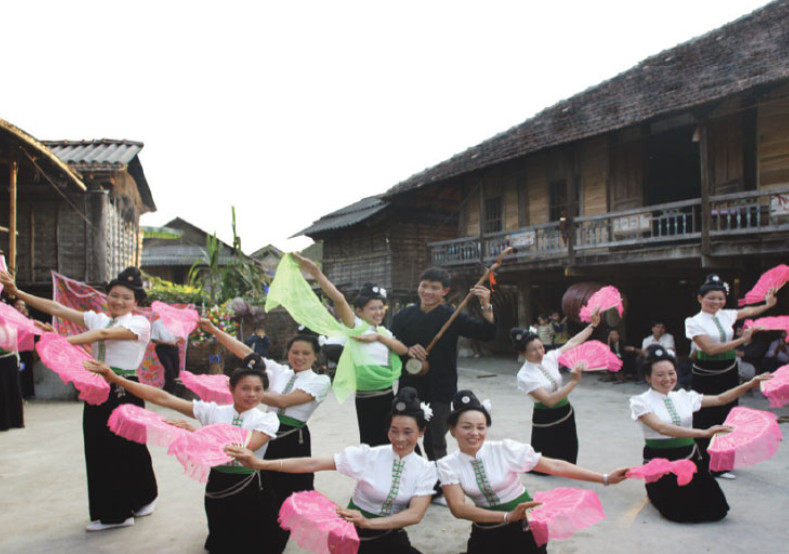Đừng bỏ lỡ những tính năng hấp dẫn của Baitap365.com
Unit 4: Our Customs And Traditions - Phong tục và truyền thống của chúng ta
Skills 2 trang 45 Unit 4 SGK Tiếng Anh 8 mới
Looking Back trang 46 SGK Unit 4 Tiếng Anh 8 mới Project trang 47 Unit 4 SGK Tiếng Anh 8 mới Skills 1 trang 44 Unit 4 SGK Tiếng Anh 8 mới Communication trang 43 Unit 4 Tiếng Anh 8 mới A Closer Look 2 trang 41 Unit 4 Tiếng Anh 8 mới A Closer Look 1 trang 40 Unit 4 Tiếng Anh 8 mới Getting started trang 38 Unit 4 SGK Tiếng Anh 8 mới Vocabulary - Phần từ vựng - Unit 4 Tiếng Anh 8 mới Grammar Unit 4 SGK Tiếng Anh 8 mới Luyện tập từ vựng Unit 4 Tiếng Anh 8 mớiSkills 2 trang 45 Unit 4 SGK Tiếng Anh 8 mới
Tưởng tượng rằng em đang tham gia một cuộc thi viết về phong tục và truyền thông và chọn viết về điệu múa Obon. Bây giờ viết một bài miêu tả về điệu múa này. Bắt đầu với câu sau đây.
Bài 1
Task 1. Look at the picture. What tradition do you think this is? Share your ideas with a partner.
(Nhìn vào hình. Bạn nghĩ đây là truyền thống nào? Chia sẻ những ý kiến của em với bạn học.)

Bài 2
Task 2. Listen to Mai's presentation and complete the table with no more than three words from the recording.
(Nghe bài thuyết trình của Mai và hoàn thành bảng với không hơn 3 từ từ bài nghe.)
|
What is the tradition? |
The xoe dance |
|
What does the dance express? |
Working life and wishes for a (1)_______ |
|
Where do people perform xoe? |
Public and (2)_______ |
|
How many xoe dance forms are there? |
More than (3)_______ |
|
What is the most popular form? |
(4)_______ |
|
Why is it the most popular? |
It expresses (5)_______ |
|
How do people perform it? |
Make a circle around the (6)_______and dance to (7)_______ |
|
Why should they continue this tradition? |
It reflects Thai (8)_______ |
Bài 3
Task 3. Listen again and tick (✔) true (T) or false (F).
(Nghe lại và chọn đúng (T) hoặc sai (F).)
|
|
T |
F |
|
1. The xoe dance is a spiritual tradition of Thai ethnic people. |
|
|
|
2. There are 16 ancient forms of xoe. |
|
|
|
3. Only young people perform the circle dance. |
|
|
|
4. Dances with conical hats, paper fans or scarves are some forms of xoe. |
|
|
|
5. The importance of xoe is expressed in an old Thai song. |
|
|
Bài 4
Task 4. Work in pairs. Read about a traditional Japanese dance. Make complete sentences, using the information given.
(Làm theo cặp. Đọc về một điệu múa Nhật Bản truyển thống. Hoàn thành câu, sử dụng thông tin được cho.)
Example:
The Obon dance is a traditional Japanese dance.
(Ubon là điệu múa truyền thống của người Nhật.)
|
What's the tradition? |
The Obon dance |
|
What does the dance express? |
People honouring their ancestors |
|
When do people perform the Obon dance? |
Obon festival, in mid- August in many regions of Japan and in mid-July in other regions |
|
How many Obon dance forms are there? |
Different forms in different regions |
|
What is the most typical form? |
Circle dance |
|
How do people perform it? |
Make a circle around a yagura, a high wooden stage; some dancers move clockwise, and some counter-clockwise |
|
Why should they continue this tradition? |
One of the most important traditions; lots of people come back to reunite with their families during the Obon festival |
Bài 5
Task 5. Imagine that you are joining a writing contest about customs and traditiond and have chosen to write about the Obon dance. Now write a description of this dance. Begin with the following sentence.
(Tưởng tượng rằng em đang tham gia một cuộc thi viết về phong tục và truyền thông và chọn viết về điệu múa Obon. Bây giờ viết một bài miêu tả về điệu múa này. Bắt đầu với câu sau đây.)
There is a tradition in Japan that people perform the Obon dance during the Obon festival. ___________________
Bài 6
Task 6. When you have finished, swap your work with a partner. Did they add anything different? Can you spot any mistakes in their work? Share your ideas.
(Khi em hoàn thành, trao đổi công việc của em với bạn học. Họ có thêm gì khác không? Em có thấy lỗi nào trong bài họ không? Chia sẻ ý kiến của em.)
Từ vựng
1.
2.
3.
4.
5.
6.
7.
8.
Mẹo tìm đáp án nhanh
Search Google: "từ khóa + baitap365" Ví dụ: "Bài 5 trang 13 SGK Vật lí 12 baitap365